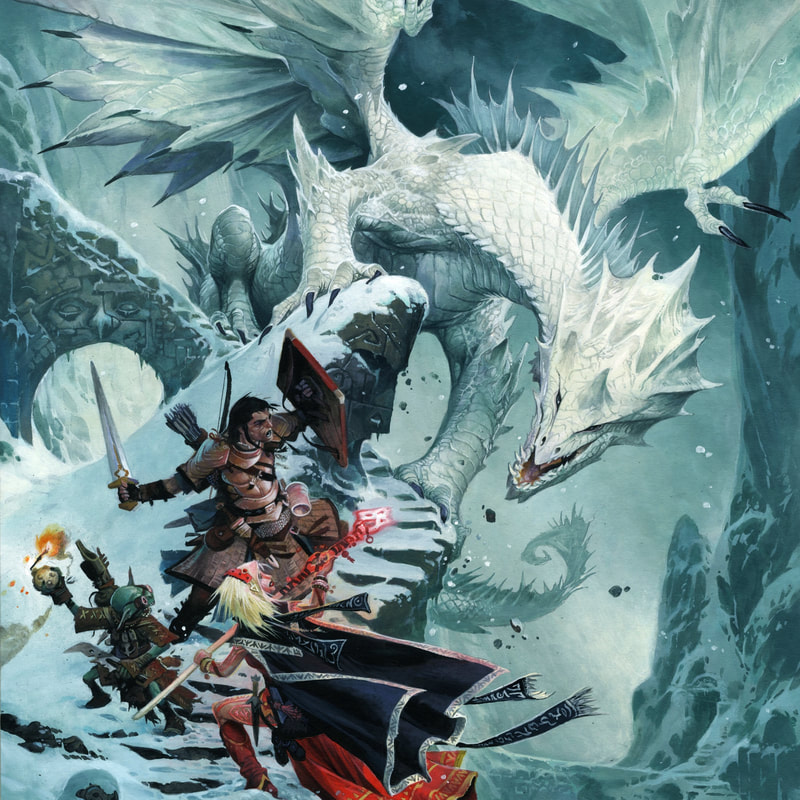|
There has been a lot of complaining about the Pathfinder playtest, and believe me, I’ve done my share of it. And though I summed up what I felt was wrong with the game as a game back in October with My Final Thoughts on The Pathfinder 2nd Edition Playtest, I’d like to talk about something tangential that I feel hasn’t been covered as much in the debate of whether or not the playtest is or is not a good game. Because I’ll admit that it’s functional, even if I feel it’s held together with duct tape and string in a couple of places. However, what it is not is Pathfinder as we know it. That isn’t just grognard-speak for, “This new version of the game isn’t the one I learned, so therefore it’s ruined!” either. Because Pathfinder wasn’t just another fantasy RPG in a market where you can hit one of those by chucking a rock. It was a game with a very distinct identity, as well as a unique heritage that allowed it to fill a particular niche. It had a brand, and the people who played it (or who asked about it) understood what made it different from the competition. This new version we’ve seen and played, though, doesn’t carry through any of that uniqueness, and it feels like it’s trying to ride the brand name without offering any of the things that players associate with the brand. For example… 1) Copying What’s Popular (Instead of Being The Unique Stand-Out) When Pathfinder first claimed its market share, it did so by lifting the falling light of the DND 3.5 engine. There were other games using it, sure, but Paizo took that engine and made it bigger, faster, louder, and stronger. They carved out their own niche, and when the 4th Edition of DND under-performed, Pathfinder existed as a viable alternative that was mechanically different from 4th Edition in a lot of meaningful ways. This new playtest, though, feels like it’s trying to play catch-up rather than stand-out. While it’s true that it isn’t exactly the same as Dungeons and Dragons 5th Edition, you can see whose homework Paizo was copying with this playtest. And while 5th Edition is a stand-out in the marketplace, it’s on the other end of the kind of play that Pathfinder tends to be associated with. So it feels like Paizo is just trying to be more like the latest success story, which isn’t working because that game already exists, and this attempt to hybridize it is just not going to appeal to players who like Classic Pathfinder or players who like 5th Edition. 2) Limiting Mechanical Freedom One of the biggest selling points Pathfinder has, in my view, is the sheer amount of mechanical freedom it offers. If you have a character concept, there is probably some way you can make it happen using the rules and options as they exist. And you aren’t just re-skinning an existing mechanic so that it looks different; you have the specific mechanics you need to manifest your idea. My best example for this is playing someone descended from storm giants. In 5th Edition, for example, there is nothing that stops you from making this claim. You can use it to justify a maxed-out strength score, and describe your character as blocky and gray-skinned. If you’re playing Pathfinder, though, you can take a feat that states explicitly that you are a storm giant for all effects related to race. And if you take a second feat, you are now immune to any effects of electricity damage. It’s more than story justification; according to the physics of the world, you have storm giant heritage. There are dozens of examples in Pathfinder Classic of this kind of mechanical freedom. You want to play a character that’s half-orc and half-elf? Cool, take this racial option and this feat. You now have a half-elf with a bite attack and tattoos, or a half-orc that can do tricks with a bow usually reserved only for elves. You want to play a Jekyll and Hyde character who literally transforms into someone else? There’s a prestige class for that. You want to be a celestial being raised on another plane who is coming to the material world as a foreigner? There’s options for that, too! The playtest, though, is all about rigidity of path and tamping down on your mechanical freedom as a player. Multiclassing is discouraged to the point that it feels token, all classes are forced to make choices that narrowly define their abilities and progression, and the new feat system has all the complexity of the old one without any of the mix-and-match ability you had to make exactly the character you want to play. One of Pathfinder’s greatest strengths as an RPG was the flexibility of its mechanics, and how you could blend them to form exactly the concept you wanted without having to bend any of the rules as they were presented. In this playtest you’re stuck with archetypes whose abilities are rigidly defined, and which gives you almost no options to meaningfully deviate from the path that’s been laid before you. 3) Pointless Complication Pathfinder was always the crunchier fantasy game on the market. If you like a game that had rules for what penalties you deal with when you’re drunk, to exactly what saves you need to make to avoid drug addiction, then Pathfinder was your jam. However, even if you found some of the rules cumbersome or unnecessary, you could at least envision situations where they would be useful. The playtest kept all the complexity, but distanced it from scenarios where it helped rather than hindered. The best example of this is the bulk system. In Pathfinder Classic (and most games with encumbrance rules) you simply look at your Strength score, and that tells you your light, medium, and heavy loads, as well as your maximum amount of ability to lift, push, etc. The playtest uses a bulk system, which means you have to look up an individual item, determine what its bulk value is, and then run your attribute through a formula to figure out how much bulk you can carry. You might argue that they were just trying to do something different, but any playtester would have told you immediately it was a bad idea. It overcomplicates a simple mechanic that most players would like to ignore in the first place, so why would you do that? You see it all over the place in the playtest. If you want to make a combat maneuver like a disarm check or a grapple (things that, previously, any character could just try to do), now you need to make a specific skill check. Not only that, but if you’re not trained in that skill, then you may not even be able to attempt the thing you’re trying to do. It’s the same line of thought that staggers out your racial abilities over a dozen levels, because it makes complete sense for a half-orc to get darkvision only once they’ve killed enough monsters to activate the eyes they were born with. Pathfinder players aren’t scared of a complicated game. But they’re used to the complications at least making sense, and too much of this game seems to have been complicated for no other reason than to make it crunchier even if those changes added nothing to the experience but irritation. For more gaming thoughts from Neal Litherland, check out his Gamers archive, his blog Improved Initiative. To read his fiction, drop by his Amazon Author Page! Picture Reference: https://paizo.com/pathfinderplaytest
John
25/1/2019 08:49:31 am
Wow. The playtest had problems but we disagree about what they were substantially. I'm still waiting to see if the final product resolves my issues or not, and I'm hopeful
Reply
darth_borehd
25/1/2019 12:23:26 pm
I think you are 100% right. I would add they are not fixing long-standing issues. They have several posts on the forums tagged as needing FAQ clarification that 2.0, at least thus far, has failed to address at all. Why should I trust them with supporting this new system if they are not supporting the old?
Reply
me
26/1/2019 11:47:25 am
TBF, PF is VERY (over)complicated, and there are a LOT of rules questions. You could make a book as big as the CRB with FAQs and clarifications. Integrating some of this into the books is one of the things I was hoping they were going to do with a new edition.
me
26/1/2019 11:44:05 am
I think we had very different interpretations of the Bulk system. I saw it as a simplification.
Reply
Dice and Slice Podcast
25/1/2019 09:57:14 am
We heavily disagree on #1. His last sentence is wrong as we are comprised of fans of classic PF and 5e players and we all love PF2e.
Reply
me
26/1/2019 12:02:04 pm
I mostly agree with you. The early blog posts showed quite a lot of promise and I liked the simplifications they seemed to be offering. But as we got to release of the PT, and the PT itself, it became apparent to me that we were not getting what was promised (or implied, at least), and though they had made some things better, they were messing up other things.
Reply
Leave a Reply. |
All blog materials created and developed by the staff here at High Level Games Archives
April 2023
Categories
All
|
Proudly powered by Weebly




 RSS Feed
RSS Feed